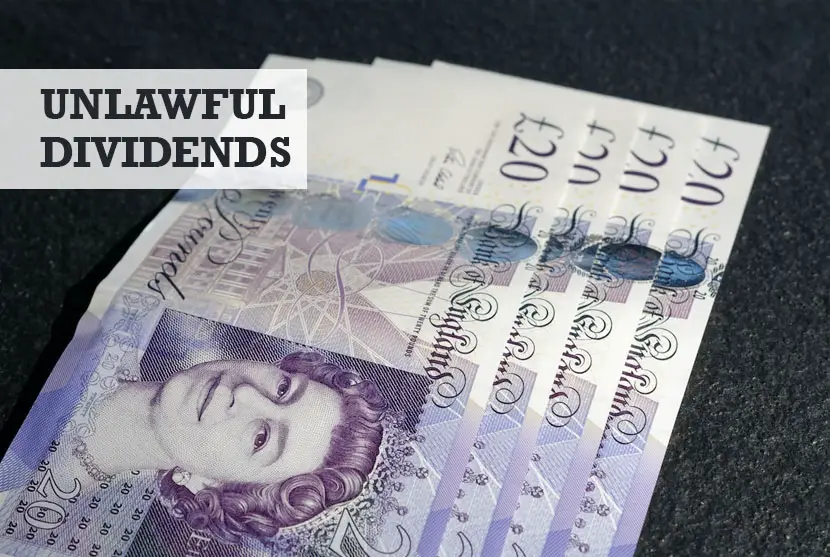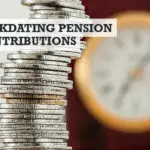There’s nothing more worrying than being under investigation by HMRC, and that’s exactly what can happen if you make unlawful dividends (also known as illegal dividends). The big problem with this situation is that it is not normally picked up until it is too late. This guide will explain what they are, what unlawful dividend consequences are, and information on rectifying an unlawful dividend.
But first, what is an unlawful dividend?
An unlawful dividend is when a company declares a dividend payment which at the time did not have sufficient distributable reserves to cover the dividend. This usually happens when amounts are paid out before accounts have been prepared but this is not an excuse as directors should be aware of the business finances.
That’s the simple answer out the way, but we implore you to read all there is to know about unlawful dividends. It’s set out in our guide below.
Guide to unlawful dividends
If you run your small business through a limited company, you could quite easily be mistaken in thinking you can take money when and how you like but that type of thinking could land you in big trouble.
A limited company is a separate legal entity. It is separate from you. You may wear several hats within that limited company for example you might be a director, an employee, or a shareholder. Three distinct separate roles all with their own legal rights and obligations.
If you wish to know more about being a director, then you should read our guide on ‘what are my responsibilities as a director of a limited company’.
It is in the role of a shareholder that you may be paid a dividend based on the performance of the business.
There are several rules and obligations that need to be carried out to understand how much can be paid out to shareholders as a dividend, when a dividend can be paid and the due process that needs to be followed to make sure the dividend is legal, rather than being an unlawful dividend.
We are not going into detail as to how much you should consider paying yourself as an owner-manager of a small, limited company but you can find out more in our ‘how much should a small business owner pay themselves’ guide to getting a better idea of how much to pay yourself.
What is an unlawful dividend?
An unlawful dividend is when dividend payments are made to shareholders more than the distributable reserves available at the point the dividend was declared. For example:
- Distributable reserves are £50,000.
- Dividend payments declared £65,000.
The Companies Act 2006 requires that amounts available for distribution are restricted to £50,000. We have created a situation where a dividend is unlawful. The company did not have sufficient profits from which to make the distribution of dividends to the shareholders.
For most small, limited companies we will assume that distributable reserves equate to accumulated, realised profits less accumulated realised losses. There are other items that may make up distributable profits, but we do not go into that in this article.
It is not unusual for director-shareholders of small, limited companies to be unaware of the rules or disregard the legislation.
This will usually happen when amounts are paid out before accounts have been prepared, quite often because of not being able to wait until the final accounts have been prepared by their accountant.
What happens if the dividend payment was unlawful?
If at the time of the dividend, the shareholder knows or should have reasonable grounds to believe that the dividend was being made unlawfully, and in contravention of the Companies Act 2006, they are liable to repay the balance drawn.
Tax implications of an unlawful dividend may result in the excess of dividends being paid versus what was available being treated as a loan to participators.
Section 455 tax will be due on any loan balance not repaid within nine months of the financial year-end.
Using our example above if the £15,000 was still due to the company after nine months of the financial year-end the Section 455 tax due will be £4,875 (£15,000 x 32.5%) and is payable at the same time as the company corporation tax.
Section 455 tax charges can be reclaimed nine months after the end of the financial year which the loan has been repaid.
Who is liable if a company makes an unlawful dividend?
Who handles making good an unlawful dividend will depend on the given circumstances. The ACCA (Associations of Certified Charted Accountants) supplies a couple of useful examples.
In It’s a Wrap (UK) Ltd v Gula [2006] EWCA Civ 544, unlawful dividends paid to members as ‘quasi-salaries’ (on the advice of their accountant to save tax!) were found on appeal to be repayable by the shareholders. Although shareholders were unaware of their unlawfulness, it was held that a shareholder was liable to return a distribution if they knew or should have been aware that it had been paid in circumstances which amounted to a contravention of the restrictions on distributions (irrespective of whether they knew of those restrictions).
Directors may become personally liable if they authorise an unlawful distribution which cannot be recovered. The repayment should be made as soon as the error is discovered, and not only in the event of a liquidation.
If the error is not corrected, the director may be held liable for any unlawful distributions due to a breach of their fiduciary and statutory duties relating to the protection of the company’s assets.
How do you rectify an unlawful dividend?
Ultimately the amount of the unlawful dividend will need to be repaid to the company. There are a few ways this can be handled:
Pay a salary
If the shareholder is also an employee of the business you may consider paying them a salary to cover the net payment received. This could be quite costly as grossing up the net payment and paying PAYE and National Insurance would make that initial dividend payment very expensive.
You will also need to factor in that a salary payment will reduce the profits available for dividends further meaning it could take longer before the company is in a position to make further dividend payments.
Don’t forget that reduction in profit will mean the original unlawful dividend will actually be at a higher amount than originally stated making this a tricky and expensive option to rectify an unlawful dividend.
Repay the unlawful dividend
Probable the quickest, easiest and simplest (provided the shareholder has not already spent the money) solution to rectify an unlawful dividend is for the directors to recover monies from the shareholders.
If and when the director becomes liable to return funds to the company this should be accounted for by debiting cash or DLA and crediting reserves, although until the amount is actually repaid it will not constitute distributable reserves. Minutes should be prepared and maintained on file to document the repayment.
Treat as a loan
As we have mentioned above you could treat the unlawful dividend as a loan to a participator and pay the Section 455 tax charge. This is possibly the more common route to rectify an unlawful dividend.
Unless the participator can repay the loan the loan could be repaid from future dividend payments. So the participator would not receive the next dividend in cash but that money could be used to settle the loan. This makes practical sense but you are then in a vicious cycle of having spent profit in advance of making it. What happens if you have a downturn in business?
The Section 455 tax charge is repayable after the loan has been repaid whereas paying a salary to clear the unlawful dividend is not. Rectifying an unlawful dividend via a loan to a participator might therefore seem like a more logical solution.
Disclosure and recognition of unlawful dividends
The ACCA (Association of Chartered Certified Accountants) give this explanation of how to disclose the unlawful dividends in the company accounts.
In the accounts of private companies in the notes or directors’ report, the directors should include references to the fact that distributions exceeded the value of distributable reserves and include an explanation of why the event occurred. This should be done irrespective of the accounting standards applied, including FRS 105.
Example 1
‘The directors acknowledge unlawful dividends were declared and paid. No further distributions have been made and the directors are seeking to recover monies from the shareholders.’
Example 2
‘At the time the dividend was paid the directors were not aware that there were insufficient profits available for distribution and the directors acknowledge that no further distributions can be made until there are sufficient profits available for that purpose.’
How to avoid unlawful dividends?
As the Company Act 2006 requires that amounts available to pay as a dividend are restricted to the amount of distributable reserves (loosely profits) at the point the dividend is declared it makes sense that you need to know what the distributable reserves figure is to avoid unlawful dividends.
The best way to avoid unlawful dividends is to make sure your bookkeeping records are up to date, and you have completed some management information such as management accounts with accruals, prepayments, inventory adjustments to name but a few of the standard accounting adjustments needed.
If you do not prepare correct management information, it is highly likely you could end up making unlawful dividends. Not knowing how to produce exact management information is not a justification for this mistake.
If the company intends on making interim dividend payments it is imperative to have correct up to date management information to avoid making multiple unlawful dividends.
FAQs on what an unlawful dividend is
Can a company lend money to an individual?
There may be occasions when a dividend is not possible from the limited company. Perhaps it has insufficient profits from which to pay you a dividend to a shareholder. If a dividend is out of the question is there another way you could extract money from the business – perhaps in your role as a director or employee maybe.
A limited company can lend money to an individual, but there are tax implications plus rules about how the money is loaned and what for. You can also borrow money yourself from your company.
If you’re considering borrowing money from your own limited company or thinking about lending money to someone else from your business, it can get messy.
There is much to consider when considering if a company can lend money to an individual. So much so that we have put together a handy guide for you to understand the implications when you are borrowing money from a limited company as a Director.
If a limited company is lending money to an individual other than yourself as a director, there are implications you need to consider before borrowing money or issuing a loan.
Can I put personal money into a limited company?
As well as taking money out of a limited company as a shareholder there may be occasions in your role as Directors or Shareholder that you wish to support the business in times of difficulty.
There are many rules, regulations, and personal considerations about putting personal money into a limited company. These rules are in place to protect you, the limited company, and its creditors.
You can put your own money into a business and limited company. It can be done as an investment through share capital, a loan to fund business activities, interest on a loan from the company or a gift.
Each scenario where you put personal money into a limited company will come with its own considerations, rules, regulations, and tax consequences.
To get a better understanding of how to put personal money into a limited company we would suggest checking out ‘putting personal money into a limited company’ which will cover this in detail.
Do dividends have to be paid equally?
The short answer is no. However, shareholders would need to hold different classes and/or percentages of shares.
Dividends are payments made to shareholders from a company’s distributable reserves, in simple terms, profits.
The distribution of those dividends needs to be paid in direct proportion to the shareholding in each class of shares. If a company has multiple classes of shares, it is possible to pay dividends to one class and not the others. However, there must be sufficient distributable reserves in the company to have paid a dividend to all classes of shares had the decision arisen.
A shareholder can also waive their right to a dividend although they must do so before the date it is paid, via a formal deed.
A waiver should only be used for genuine commercial reasons and not as a mechanism to avoid paying personal tax.
However, there must be sufficient distributable reserves in the company to have paid a dividend to all classes of shares had the decision arisen e.g., a waived dividend cannot then be distributed amongst the remaining shareholders. This is where different classes of shares become relevant.
A shareholder’s agreement is always advisable in these situations to clearly set out the rules of when dividends will be paid and the circumstances that need to be adhered to.
How do I vote dividends legally?
Companies Act 2006 (CA 2006 (s830)) states that ‘a company may only make a distribution out of profits available for the purpose’.
Before declaring a dividend, the company’s directors must hold a board meeting and keep the minutes of the meetings (on paper or electronic format) with their statutory records (CA 2006 s388).
For each dividend a company issues, a voucher must be created and given to its shareholder.
For interim dividends, full accounts are not needed. However, the directors must have sufficient information available to enable them to make a reasonable judgement as to whether the amount of the ‘distributable profits’ at the date of payment is acceptable.
Conclusion
Understanding what an unlawful dividend is and how to avoid it is relatively simple when you know your way around the rules. A director of a limited company is expected to know this.
The most important thing is to have a firm grasp of the business financials. The key element is whether you believed the business had enough distributable profits at the time the dividend was declared. The most efficient way to prove that is to have correct up to date management information.
Getting this wrong can lead to an expensive and time time-consuming clean-up process. If in doubt don’t pay out. Perhaps consider remunerating yourself in another way such as salary or even a short-term loan from the business.
All options you should discuss with your accountant or bookkeeper to ensure you stay within the letter of the law and minimise your taxes.
Image in header from https://unsplash.com/photos/8WRRJ4xJeyg

Jon has been in business since 1999, and in that time worked with more than 300 small business clients. As well as being an accountant, he is also an early adopter of tech, and has helped small businesses to leverage the power of their computer systems by creating software to automate and simplify accounting tasks.






